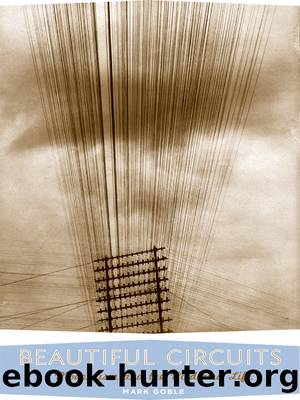Beautiful Circuits by Goble Mark;

Author:Goble, Mark;
Language: eng
Format: epub
Tags: Social Science/Media Studies
Publisher: Columbia University Press
Published: 2011-10-11T16:00:00+00:00
Figure 3.6. Cover illustration for the sheet music to “The Castle Innovation Tango,” 1914. Collection of the author.
Let me begin answering these questions by posing yet another: why is the phonograph sitting down? On acoustic grounds alone, an easy chair is an odd place to put a record player, but this is not my point. I am fascinated instead by the way this image lends an almost human presence to the phonograph, as if this were its living room, as if the Castles were dancing for its entertainment. The effect I am describing partly comes from the mix of media from which the picture has been fashioned: the photographic Castles do not seem entirely at home here; the plane of the picture is too flat to accommodate their scale, and their realism is rendered weightless and uncanny when set against the sketched-in walls and hand-drawn carpeting; even the chair, which is somewhat modeled as an object in three dimensions, is more cartoonish than photographic. If the phonograph is here by mistake—an instance of visual catachresis, since what it should be is the piano on which this music may be played—so too are the Castles, who have both stepped into a space where media technologies reside more comfortably than human beings. Which is to say that if this phonograph is strangely anthropomorphized by being given the seat of honor for a command performance by the celebrated Vernon and Irene Castle, then it also figures an aesthetic that is more powerfully realized and embodied when its author is altogether mediated. When someone buys a copy of the “Castle Innovation Tango”—a white consumer, if this cover is taken at face value—and sits down at the piano, that person will become the instrument of James Reese Europe and Ford Dabney, two black musicians who, like Johnson’s ex-colored man, possess the ability to make white people move at their command, perhaps not always “involuntarily and unconsciously” but still by means of an elaborate system of racial fantasy and remote control. The Castles can plainly dance without their all-black orchestra, but they need some object to materialize the racialized aesthetic that their bodies at once express and sublimate in their curious performance for the phonograph itself. The same circuitous arrangement that translates ragtime into something more “respectable” all but inscribes the presence of race wherever there is a technology for making music.
It is this network of displacements and associations that informs the ex-colored man’s experience of being used by his white patron as a virtual pianola. After the success of his first private performance, his new “millionaire friend,” as the ex-colored man comes to call him, offers an exclusive “contract” guaranteeing “lots of work,” but also with the following “stipulation”: “that I should not play any engagements such as I had just filled for him, except by his instructions” (120). But the terms of this contract, freely entered, to be sure, seem to invite comparison to the slavery’s protocols of ownership and objectification. It is not
Download
This site does not store any files on its server. We only index and link to content provided by other sites. Please contact the content providers to delete copyright contents if any and email us, we'll remove relevant links or contents immediately.
Kathy Andrews Collection by Kathy Andrews(10510)
The remains of the day by Kazuo Ishiguro(7544)
Spare by Prince Harry The Duke of Sussex(4188)
Paper Towns by Green John(4165)
The Body: A Guide for Occupants by Bill Bryson(3791)
Be in a Treehouse by Pete Nelson(3207)
Harry Potter and the Goblet Of Fire by J.K. Rowling(3025)
Goodbye Paradise(2950)
Never by Ken Follett(2873)
Into Thin Air by Jon Krakauer(2695)
The Remains of the Day by Kazuo Ishiguro(2614)
The Genius of Japanese Carpentry by Azby Brown(2602)
The Cellar by Natasha Preston(2592)
Drawing Shortcuts: Developing Quick Drawing Skills Using Today's Technology by Leggitt Jim(2529)
120 Days of Sodom by Marquis de Sade(2428)
Architecture 101 by Nicole Bridge(2348)
The Man Who Died Twice by Richard Osman(2291)
Machine Learning at Scale with H2O by Gregory Keys | David Whiting(2269)
Fairy Tale by Stephen King(2059)
